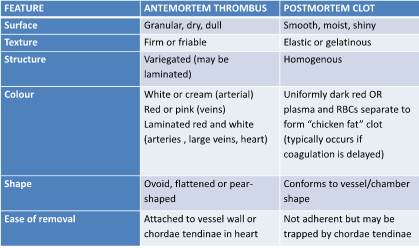Apparently, either you cannot read, refuse to read, or you are being wilfully obtuse.
Blood clots formed before death adhere to the vessel walls and have a rough surface. Here are the links *againn*:
****
“A postmortem clot (E-Fig. 1-5) can be distinguished from an antemortem thrombus by its smooth shiny surface and lack of lamination or attachment to the endothelial surface of the vessel. However, depending on the erythrocyte sedimentation rate, a postmortem clot can organize within a vessel just as within a test tube, with erythrocytes at the bottom separated by a “buffy coat” of leukocytes from the serum at the top. The resemblance of clotted serum to avian adipose tissue has garnered the name of “chicken fat clot” for this postmortem clot that is often seen in horses because of their high erythrocyte sedimentation rate. Inflammation can accelerate the sedimentation rate. Anticoagulants or hereditary coagulopathies can delay or prevent postmortem clotting of blood.”
Link: https://www.sciencedirect.com/topics/nursing-and-health-professions/livor-mortis
*****
Also here:
https://pubmed.ncbi.nlm.nih.gov/18243759/

Re your If extensive clots can kill (and they can), one has to distinguish the clots reported by these sources, unambiguously from extensive clots known to have formed before death, in those known to be free of both the COOF and to never have had significant amounts of spike protein in their system, whether from the jabs or from (say) shedding by a contact who had been jabbed.
This is difficult to parse. Syntax off much? I gather you again assert that that three-foot long clots can form in a living person, but offer no proof. No links, no nothing, just your word for it.
Again, the clots the embalmer removed were not stuck to the vessel walls, were easily pulled out, conformed to the shape of the blood vessel, were rubbery and/or gelatinous and had a smooth shiny surface. All the characteristics of postmortem clots, not antemortem thrombi.
This is difficult to parse. Syntax off much? I gather you again assert that that three-foot long clots can form in a living person, but offer no proof. No links, no nothing, just your word for it. Suck it dry, troll.
https://scarysymptoms.com/2013/04/how-long-length-can-dvt-be/
This site does not allow copy-and-paste, so I'll type in 1 paragraph by hand.
"In terms of length or extent of a DVT, they can range from those that are very focal (a couple of mm only) to extensive clot throughout the length of the leg, and even into the iliac veins and inferior vena cava," says Paul Lucas, MD, surgeon with the Vascular Center and director of the Vascular Laboratory at Mercy Hospital in Baltimore.
https://vascularcme.com/2016/01/15/how-big-are-blood-clots/
What the patient or clinician may not understand is that this patient may have blood clots from the calf extending above the knee or into the pelvis and/or abdomen. These larger blood clots are obviously deadly if the travel, but also have clinical signs that are easy to identify. Large obstructive thrombus in the iliac or femoral veins (ilio-femoral) can cause a condition that is called phlegmasia alba dolens or milk leg as the extremity will have a white milky appearance along with swelling and pain. If the thrombus extends into the smaller tributary veins as well a very serious condition called phlegmasia cerulea dolens can occur. There is pronounced edema and sever cyanosis of the limb (blue color). In rare cases venous gangrene occurs. The largest demographic for these larger blood clots are those in their 50’s and 60’s. Cancer is the most common triggering factor; however there are other risk factors.
These larger blood clots often when not diagnosed are fatal. I have had a patient walk in the door with a blood clot extending from the calf all the way to the mid abdomen (IVC). Recently a California man had a 24 in. or 60 cm. clot removed via a device called an AngioVac. The thrombus extended from his legs into the heart. There are several such devices on the market; these types of advancements have increased the effectiveness of treatment for larger blood clots. For blood clots or DVT that are not obstructive in the thigh or pelvis the use of anticoagulation drugs (blood thinners) is common. We will talk about the various kinds of blood thinners available in another blog.




